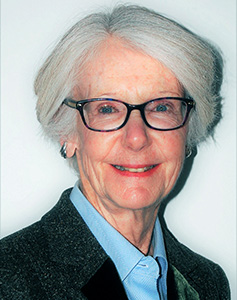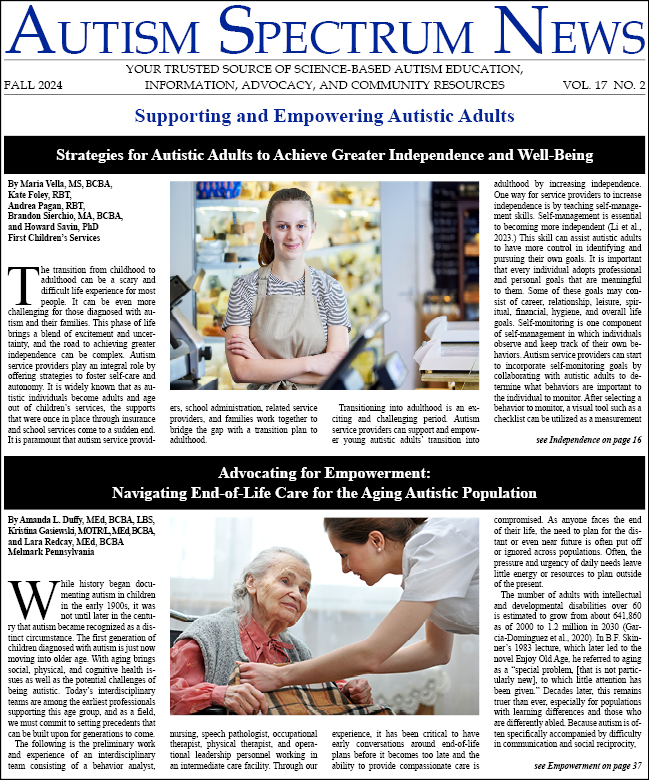As a student’s remaining time in high school dwindles down to a year or two, school district personnel are challenged to meet the expectations of both students and parents regarding life after high school. Post-secondary education transition brings its own set of challenges while employment opportunities for those not going on to further educational programs involve quite another set of more complex and unchartered demands and expectations.

Although many districts provide work experience programs in a student’s final year, the shift from school work experience programs to employment is quite dramatic. Some parents have described it as falling off a cliff and are left to wonder if a parachute will open in the form of an employment opportunity. Many parents fear, what many of us know from research, that many individuals with autism will remain highly dependent upon their families well into adulthood (Howlin, p.112). It is a seismic shift from school programs to employment.
School programs for persons with disabilities is an entitlement with services, supports and due process required under the Individuals with Disabilities Education Act (IDEA). Employment, unlike education, is guided by the Americans with Disabilities Act (ADA) that is civil rights legislation providing safeguards for persons with disabilities in the areas of employment, housing, and transportation among others.

Laura H. DiGalbo, MEd

Ruth Eren, EdD
As consultants to programs that are faced with this seismic shift, the authors have identified seven common transition issues that have confused and frustrated parents. These issues, if misunderstood or not fully explained, often create misunderstanding and communication issues between parents, their adult son or daughter, potential employers and adult providers of vocational services. Although the seven issues are not based on a formal research project, the authors believe in their critical importance through their active consultation and interaction with the many parties involved with the transition process. The authors strongly believe if the seven issues are fully understood by all parties involved, a bridge between the education environment and the employment environment can be constructed allowing the transition from school to employment to be a much smoother (yet still challenging), process! The following is brief list of the seven issues that demonstrate the shift between the two worlds the young adult is moving from and to:
Issue #1: Transition Focus vs. On Demand Environment
Education Environment – Transition Focus
Students are instructed in programs that are individualized. Instruction is tailored to meet their learning style, educational, and environmental needs.
Employment Environment – On Demand Environment
Employees are expected to execute duties when instructed to do so, to the best of their abilities, with or without accommodations.
Issue #2: Development of Life Skills vs. Execution of Job Requirements
Education Environment – Development of Life Skills
School curriculum is still very much focused on instruction in independent living skills, social communication competencies and the development of self-determination.
Employment Environment – Execution of Job Requirements
Employment is solely about getting the job done correctly and efficiently, with or without accommodations.
Issue #3: Individuals with Disabilities Education Act (IDEA) vs. Americans with Disabilities Act (ADA)
Education Environment – Individuals with Disabilities Education Act (IDEA)
Individuals with disabilities law is a law of entitlement that ensures students with disabilities be provided individualized programming and due process if a student does not demonstrate progress.
Employment Environment – Americans with Disabilities Act (ADA)
Civil rights legislation/ADA insures that “eligible” persons with disabilities are given equal access to employment with or without accommodations.
Issue #4: Manifestation Determination vs. Otherwise Qualified
Education Environment – Manifestation Determination
Under IDEA a student cannot be denied an education if his inappropriate behavior is a manifestation of his disability. A suitable educational program must be provided, and the behavior must be addressed with supports and additional services if necessary.
Employment Environment – Otherwise Qualified
Under ADA an employee must be able to meet the essential functions of the job, including behavioral expectations, with or without accommodations; to be considered qualified for the job or to remain on the job.
Issue #5: Parental Influence vs. Self-Determination Executed
Education Environment – Parental Influence
Up until the age of 18, a parent can accept and approve all services and programs offered. Once the student reaches 18, those rights belong to him unless the student is under guardianship of the parent. In that case, parents continue to have a voice in their young adult’s educational program.
Employment Environment – Self-Determination Executed
Parents do not have a voice in the employment environment unless the parent has been deemed guardian of the employee by the adult court. Employees must advocate for themselves.
Issue #6: Modifications vs. Accommodations
Education Environment – Modifications
Under IDEA modifications can be made to allow a student with a disability to be maintained in the general education setting with the curriculum modified to meet his instructional needs.
Employment Environment – Accommodations
Under the ADA employees may have disability related accommodations to the process of executing job tasks. Modifications of essential job tasks are not included in the Law.
Issue #7: Pre-Vocational Exploration/Training vs. Individualized/Customized Employment
Education Environment – Pre-Vocational Exploration/Training
In the school setting, pre-vocational training and sometimes career exploration in various jobs can occur. Often this includes group placements and the support of a vocational rehabilitation agency along with significant modifications on the job site.
Employment Environment – Individualized/Customized Employment
If exiting students with disabilities choose to enroll or continue with vocational services, the provider will deliver supports only in individualized, competitive employment settings. No longer are group settings used for vocational skill development on the job site.
Conclusion
These seven issues have been identified by the authors, one of whom has extensive background and experience in special education, the other has over 30 years of experience in state agencies involved with employment for people with disabilities. Through their consultation work with programs for adults with disabilities who are seeking employment, and working as a team, these issues continued to surface as prominent challenges. The nature of the consultation allowed the authors the luxury of stepping back in order to look at the overall process involved when a person with disabilities transitions from the educational environment to the environment of employment. The expertise of the consultants allowed for collaboration and most importantly, direct communication between the system of school- based transition services and adult employment services.
There was a unique opportunity for the different philosophies and structure of each of the two environments to be discussed and more fully explained. This is not always possible in the transition process where the focus is on the student soon to be adult, entering the world of work. Process can sometimes be overlooked. The authors are very grateful to have had this unusual opportunity to work together and share perspectives. The seven issues cited above are a direct result of this collaboration and will hopefully serve as a bridge that will help schools, parents, employers and most importantly, adults with disabilities, work toward a more effective transition from the education environment to the employment environment.
Ruth Eren, EdD, is Professor Emerita and Director (Retired) at the Center of Excellence on ASD at Southern Connecticut State University in New Haven, CT. Laura H. DiGalbo, MEd, is a Nationally Certified Rehabilitation Counselor (CRC) and a Licensed Professional Counselor (LPC). For more information, contact Dr. Eren at Erenr1@southernct.edu and Laura at ldgalbo@aol.com.
References
Americans with Disabilities Act of 1990. Public Law 101-336. 108th Congress, 2nd session (July 26, 1990).
Howlin, P.(2014).Outcomes in adults with autism spectrum disorders. In Volkmar, Rogers, Paul, Pelphrey (Eds.) Handbook of autism and pervasive developmental disorders, 4th Ed.(pp.97-116) Hobken, NJ:Wiley.
Individuals with Disabilities Education Improvement Act of 2004, Pub.L. No. 108-446, 118, Stat. 2647 (2004).




